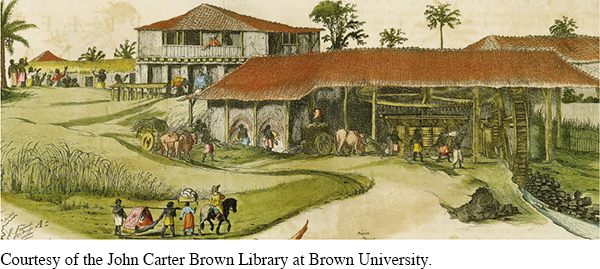Slave Labor Emerges in the Chesapeake
By 1700, more than eight out of ten people in the southern colonies of English North America lived in the Chesapeake. Until the 1670s, almost all Chesapeake colonists were white people from England. By 1700, however, one out of eight people in the region was a black person from Africa. A few black people had lived in the Chesapeake since the 1620s, but the black population grew fivefold between 1670 and 1700 as hundreds of tobacco planters made the transition from servant to slave labor.
Planters saw several advantages to purchasing slaves rather than servants. Although slaves cost three to five times more than servants, slaves never became free. Because the mortality rate had declined by the 1680s, planters could reasonably expect a slave to live longer than a servant’s period of indenture. Slaves also promised to be a perpetual labor force since children of slave mothers inherited the status of slavery. And unlike servants, they could be controlled politically. A slave labor system promised to avoid the political problems such as Bacon’s Rebellion caused by the servant labor system. Slavery kept discontented laborers in permanent servitude, and their color was a badge of their bondage.

The slave labor system polarized Chesapeake society along lines of race and status: All slaves were black, and nearly all blacks were slaves; almost all free people were white, and all whites were free or only temporarily bound in indentured servitude. Unlike Barbados, however, the Chesapeake retained a vast white majority. Among whites, huge differences of wealth and status still existed. By 1700, more than three-quarters of white families had neither servants nor slaves. Nonetheless, poor white farmers enjoyed the privileges of free status. They could own property, get married, have families, and bequeath their property and their freedom to their descendants; they could move when and where they wanted; they could associate freely with other people; they could serve on juries, vote, and hold political office; and they could work, loaf, and sleep as they chose. These privileges of freedom—none of them possessed by slaves—made lesser white folk feel they had a genuine stake in the existence of slavery, even if they did not own a single slave. By emphasizing the privileges of freedom shared by all white people, the slave labor system reduced the tensions between poor folk and grandees that had plagued the Chesapeake region in the 1670s.
< CONSIDER CAUSE AND EFFECT
How did the growth of the slave labor system in Virginia reshape the social and economic dynamics of the colony? What problems did it diminish, and what problems did it create?
In contrast to slaves in Barbados, most slaves in the seventeenth-century Chesapeake colonies had frequent and close contact with white people. Slaves and white servants performed the same tasks on tobacco plantations, often working side by side in the fields. Slaves took advantage of every opportunity to slip away from white supervision and seek out the company of other slaves. Planters often feared that slaves would turn such seemingly innocent social pleasures to political ends, either to run away or to conspire to strike against their masters. Slaves often did run away, but they were usually captured or returned after a brief absence. Despite planters’ nightmares, slave insurrections did not occur.
Although slavery resolved the political unrest caused by the servant labor system, it created new political problems. By 1700, the bedrock political issue in the southern colonies was keeping slaves in their place, at the end of a hoe. The slave labor system in the southern colonies stood roughly midway between the sugar plantations and black majority of Barbados to the south and the small farms and homogeneous villages that developed in seventeenth-century New England to the north (see “Religious Controversies and Economic Changes” in chapter 4).
> QUICK REVIEW
Why had slave labor largely displaced indentured servant labor by 1700 in Chesapeake tobacco production?
Understanding the American Promise 3ePrinted Page 72
Section Chronology